Modelling and Prediction of Organic Carbon Dynamics in Arable Soils Based on a 62-Year Field Experiment in the Voronezh Region, European Russia
Abstract
:1. Introduction
2. Materials and Methods
3. Results
3.1. Modelling C Intake During the Long-Term Experiment
3.2. Forecast of C Fixation in the Soil for the Period 2016–2090
- Business-as-usual (BAU) with the application of 25 t·ha−1 of FYM per crop rotation (20% row crops, 10% fallow);
- BAU with the application of 52 t·ha−1 of FYM for crop rotation (20% row crops, 10% fallow);
- Sustainable (SUS) grain-row crop rotation with the application of 25 t·ha−1 of FYM per crop rotation (20% row crops, 80% crops of continuous sowing);
- SUS rotation with the application of 52 t·ha−1 of FYM for crop rotation (20% row crops, 80% crops of continuous sowing).
4. Discussion
4.1. Long-Term Trends in SOC Stock in Soils under Intensive Farming
4.2. SOM and Soil Health under Climatic Change
5. Conclusions
Author Contributions
Funding
Conflicts of Interest
References
- Smith, J.; Smith, P.; Wattenbach, M.; Gottschalk, P.; Romanenkov, V.; Shevtsova, L.K.; Sirotenko, O.D.; Rukhovich, D.I.; Koroleva, P.V.; Romanenko, I.A.; et al. Projected changes in the organic carbon stocks of cropland mineral soils of European Russia and the Ukraine, 1990–2070. Glob. Chang. Biol. 2007, 13, 342–356. [Google Scholar] [CrossRef]
- Rumpel, C. Soils linked to climate change. Nature 2019, 572, 442–443. [Google Scholar] [CrossRef]
- Vermeulen, S.; Bossio, D.; Lehmann, J.; Luu, P.; Paustian, K.; Webb, C.; Augé, F.; Bacudo, I.; Baedeker, T.; Havemann, T.; et al. A global agenda for collective action on soil carbon. Nat. Sustain. 2019, 2, 2–4. [Google Scholar] [CrossRef]
- Lajtha, K.; Bowden, R.D.; Crow, S.; Fekete, I.; Kotroczó, Z.; Plante, A.F.; Simpson, M.J.; Nadelhoffer, K.J. The detrital input and removal treatment (DIRT) network: Insights into soil carbon stabilization. Sci. Total Environ. 2018, 640, 1112–1120. [Google Scholar] [CrossRef] [PubMed]
- Fekete, I.; Lajtha, K.; Kotroczó, Z.; Várbíró, G.; Varga, C.; Tóth, J.A.; Demeter, I.; Veperdi, G.; Berki, I. Long-term effects of climate change on carbon storage and tree species composition in a dry deciduous forest. Glob. Chang. Biol. 2017, 23, 3154–3168. [Google Scholar] [CrossRef] [PubMed]
- Kibblewhite, M.; Ritz, K.; Swift, M. Soil health in agricultural systems. Philos. Trans. R. Soc. B Biol. Sci. 2007, 363, 685–701. [Google Scholar] [CrossRef] [Green Version]
- Montanarella, L.; Pennock, D.J.; McKenzie, N.; Badraou, M.; Chude, V.; Baptista, I.; Mamo, T.; Yemefack, M.; Aulakh, M.S.; Yagi, K.; et al. World’s soils are under threat. SOIL Discuss. 2016, 2, 79–82. [Google Scholar] [CrossRef] [Green Version]
- Soussana, J.-F.; Lutfalla, S.; Ehrhardt, F.; Rosenstock, T.; Lamanna, C.; Havlík, P.; Richards, M.; Wollenberg, E.; Chotte, J.-L.; Torquebiau, E.; et al. Matching policy and science: Rationale for the ‘4 per 1000—soils for food security and climate’ initiative. Soil Tillage Res. 2019, 188, 3–15. [Google Scholar] [CrossRef]
- Minasny, B.; Malone, B.P.; McBratney, A.B.; Angers, D.A.; Arrouays, D.; Chambers, A.; Chaplot, V.; Chen, Z.-S.; Cheng, K.; Das, B.S.; et al. Soil carbon 4 per mille. Geoderma 2017, 292, 59–86. [Google Scholar] [CrossRef]
- Poulton, P.; Johnston, J.; Macdonald, A.; White, R.; Powlson, D. Major limitations to achieving “4 per 1000” increases in soil organic carbon stock in temperate regions: Evidence from long-term experiments at Rothamsted Research, United Kingdom. Glob. Chang. Biol. 2018, 24, 2563–2584. [Google Scholar] [CrossRef] [Green Version]
- Krasilnikov, P.; Sorokin, A.; Golozubov, O.; Bezuglova, O. Managing Chernozems for Advancing SDGs. In Soil and Sustainable Development Goals; Lal, R., Horn, R., Kosaki, T., Eds.; GeoEcology Essays; Catena-Schweizerbart: Stuttgart, Germany, 2018; pp. 175–188. [Google Scholar]
- Sorokin, A.; Owens, P.; Láng, V.; Jiang, Z.-D.; Michéli, E.; Krasilnikov, P. “Black soils” in the Russian Soil Classification system, the US Soil Taxonomy and the WRB: Quantitative correlation and implications for pedodiversity assessment. Catena 2021, 196, 104824. [Google Scholar] [CrossRef]
- Romanenkov, V.; Belichenko, M.; Petrova, A.; Raskatova, T.; Jahn, G.; Krasilnikov, P. Soil organic carbon dynamics in long-term experiments with mineral and organic fertilizers in Russia. Geoderma Reg. 2019, 17, e00221. [Google Scholar] [CrossRef]
- Doran, J.W.; Zeiss, M.R. Soil health and sustainability: Managing the biotic component of soil quality. Appl. Soil Ecol. 2000, 15, 3–11. [Google Scholar] [CrossRef] [Green Version]
- Minakova, O.A.; Alexandrova, L.V.; Kunitsyn, D.A. Change of soil fertility and sugar beet yield under long-term application of fertilizers in grain-fallow-row crop rotation of the forest-steppe of Central Black earth region. Agrokhimia 2018, 1, 52–60. (In Russian) [Google Scholar]
- Tyurin, I.V. Soil Organic Matter and its Role in Pedogenesis and Soil Productivity. Study of Soil Humus; Seľskozgiz: Moscow, Russia, 1937; p. 322. (In Russian) [Google Scholar]
- Smith, P.; Smith, J.; Powlson, D.; McGill, W.; Arah, J.; Chertov, O.; Coleman, K.; Franko, U.; Frolking, S.; Jenkinson, D.; et al. A comparison of the performance of nine soil organic matter models using datasets from seven long-term experiments. Geoderma 1997, 81, 153–225. [Google Scholar] [CrossRef]
- Levin, F.I. Amount of plant residues of field crops and its determination according to the yield of the main product. Agrokhimiya 1977, 8, 36–42. (In Russian) [Google Scholar]
- Körschens, M.; Albert, E.; Armbruster, M.; Barkusky, D.; Baumecker, M.; Behle-Schalk, L.; Bischoff, R.; Čergan, Z.; Ellmer, F.; Herbst, F.; et al. Effect of mineral and organic fertilization on crop yield, nitrogen uptake, carbon and nitrogen balances, as well as soil organic carbon content and dynamics: Results from 20 European long-term field experiments of the twenty-first century. Arch. Agron. Soil Sci. 2013, 59, 1017–1040. [Google Scholar] [CrossRef]
- Edmeades, D.C. The long-term effects of manures and fertilisers on soil productivity and quality: A review. Nutr. Cycl. Agroecosyst. 2003, 66, 165–180. [Google Scholar] [CrossRef]
- Maillard, É.; Angers, D.A. Animal manure application and soil organic carbon stocks: A meta-analysis. Glob. Chang. Biol. 2013, 20, 666–679. [Google Scholar] [CrossRef]
- Han, P.; Zhang, W.; Wang, G.; Sun, W.; Huang, Y. Changes in soil organic carbon in croplands subjected to fertilizer management: A global meta-analysis. Sci. Rep. 2016, 6, 27199. [Google Scholar] [CrossRef] [PubMed] [Green Version]
- Wang, G.; Luo, Z.; Han, P.; Chen, H.; Xu, J. Critical carbon input to maintain current soil organic carbon stocks in global wheat systems. Sci. Rep. 2016, 6, 1–8. [Google Scholar] [CrossRef] [PubMed] [Green Version]
- Ren, J.; Wang, L.; Yang, X.; Zhang, X.; Fang, H.; Zhu, P. Long-Term Effects of Fertilization on Soil Organic Carbon Changes in Continuous Corn of Northeast China: RothC Model Simulations. Environ. Manag. 2003, 32, 459–465. [Google Scholar] [CrossRef] [PubMed]
- Lou, Y.; Wang, J.; Liang, W. Impacts of 22-year organic and inorganic N managements on soil organic C fractions in a maize field, northeast China. Catena 2011, 87, 386–390. [Google Scholar] [CrossRef]
- Giacometti, C.; Demyan, M.S.; Cavani, L.; Marzadori, C.; Ciavatta, C.; Kandeler, E. Chemical and microbiological soil quality indicators and their potential to differentiate fertilization regimes in temperate agroecosystems. Appl. Soil Ecol. 2013, 64, 32–48. [Google Scholar] [CrossRef]
- Leifeld, J.; Reiser, R.; Oberholzer, H.R. Consequences of Conventional versus Organic farming on Soil Carbon: Results from a 27-Year Field Experiment. Agron. J. 2009, 101, 1204–1218. [Google Scholar] [CrossRef]
- Krasilnikov, P.; Makarov, O.; Alyabina, I.; Nachtergaele, F. Assessing soil degradation in northern Eurasia. Geoderma Reg. 2016, 7, 1–10. [Google Scholar] [CrossRef]
- Chen, H.; Zhao, Y.; Feng, H.; Li, H.; Sun, B. Assessment of climate change impacts on soil organic carbon and crop yield based on long-term fertilization applications in Loess Plateau, China. Plant Soil 2014, 390, 401–417. [Google Scholar] [CrossRef]
- Peltre, C.; Christensen, B.T.; Dragon, S.; Icard, C.; Kätterer, T.; Houot, S. RothC simulation of carbon accumulation in soil after repeated application of widely different organic amendments. Soil Biol. Biochem. 2012, 52, 49–60. [Google Scholar] [CrossRef]
- Kocsis, T.; Biró, B.; Ulmer, Á.; Szántó, M.; Kotroczó, Z. Time-lapse effect of ancient plant coal biochar on some soil agrochemical parameters and soil characteristics. Environ. Sci. Pollut. Res. 2017, 25, 990–999. [Google Scholar] [CrossRef]
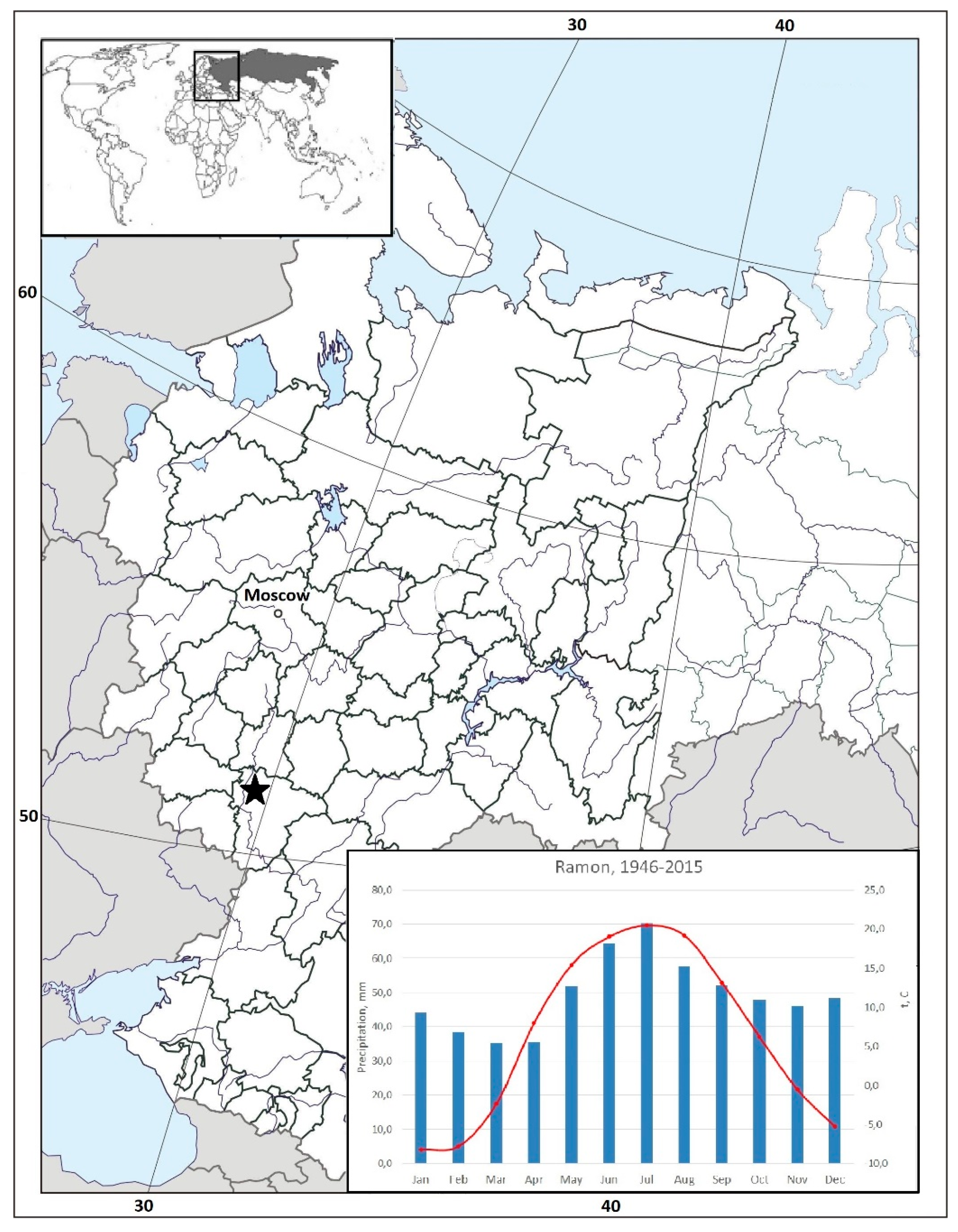
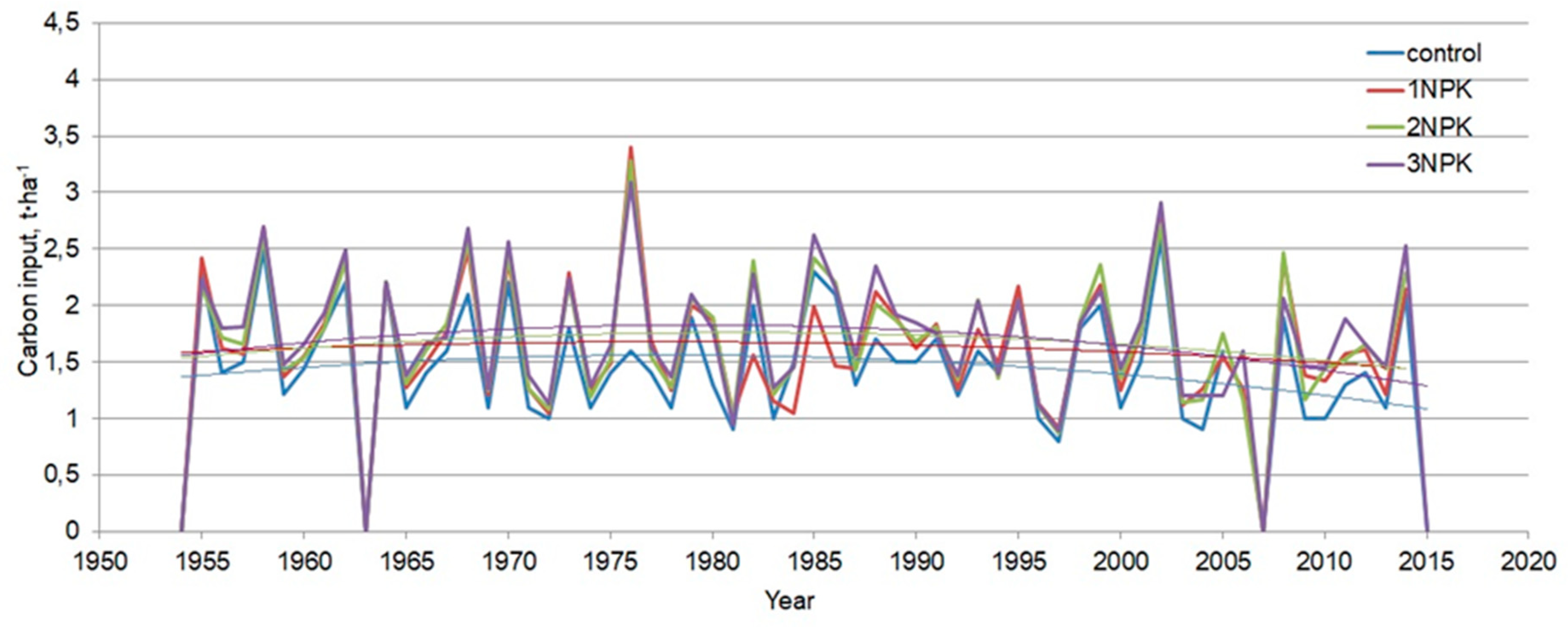
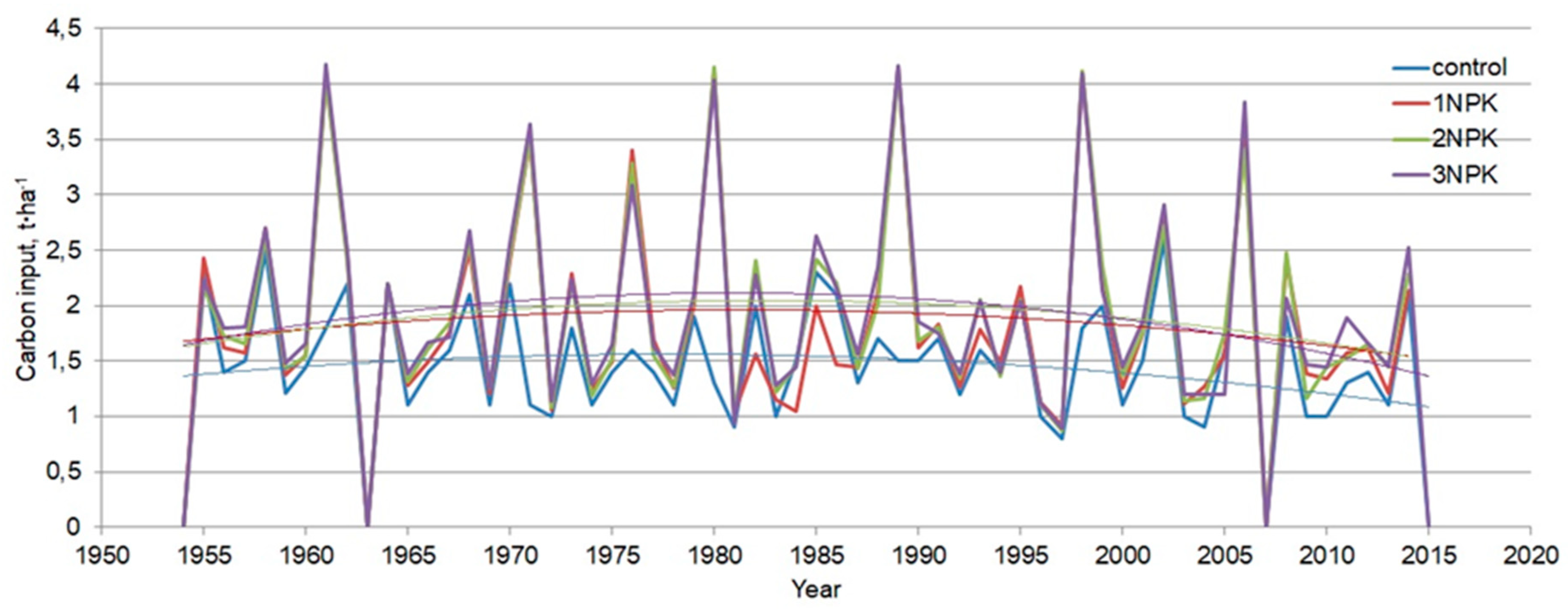
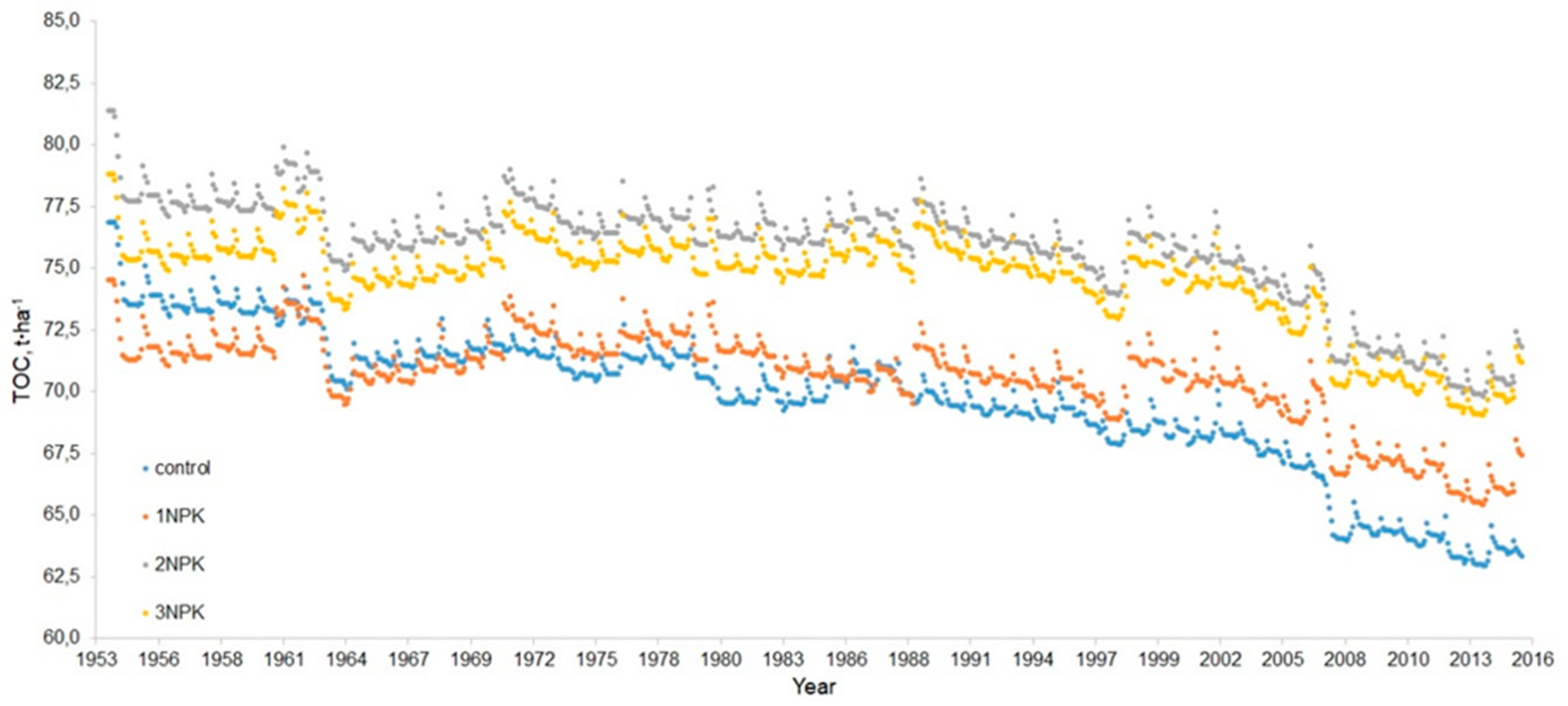

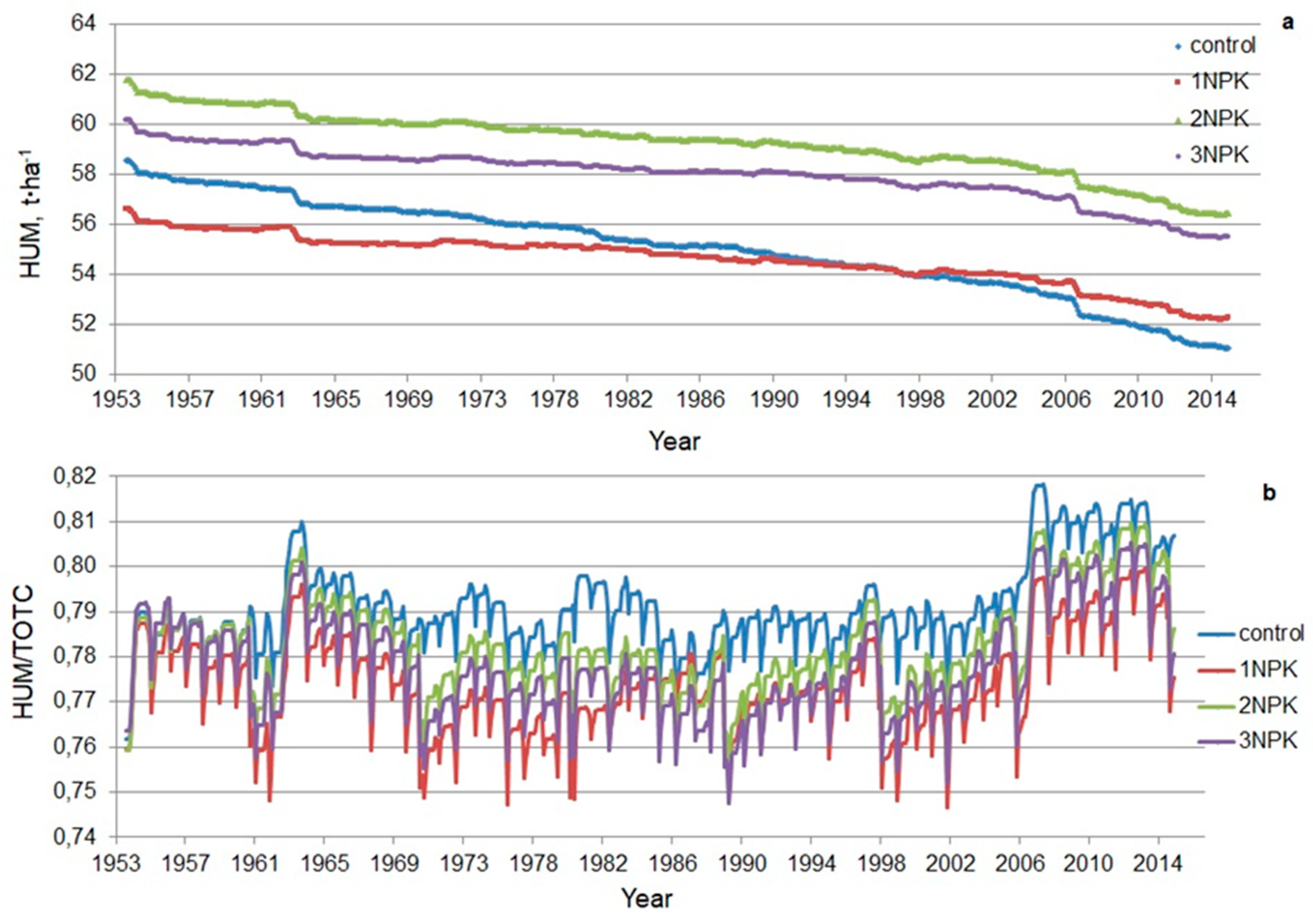
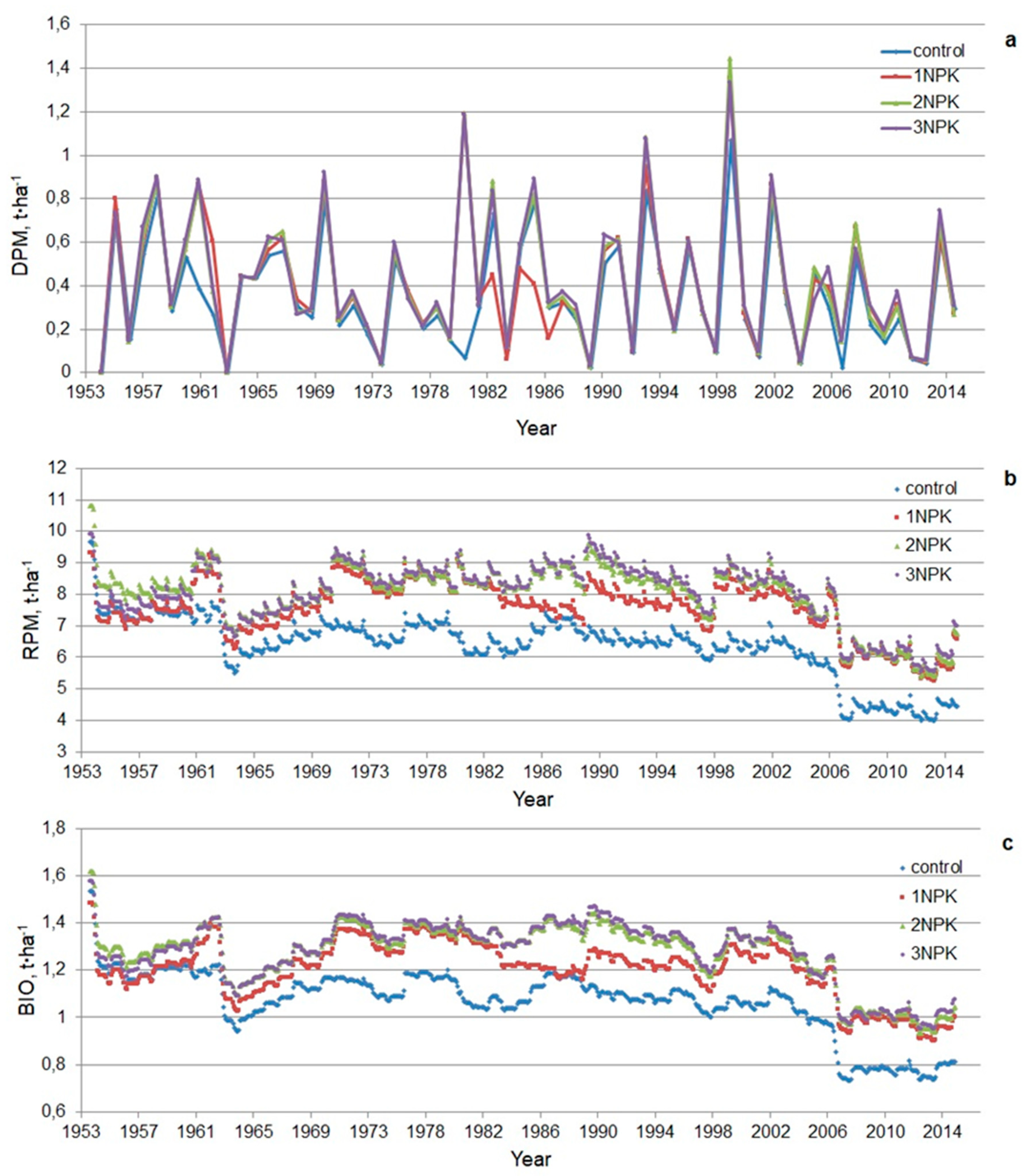
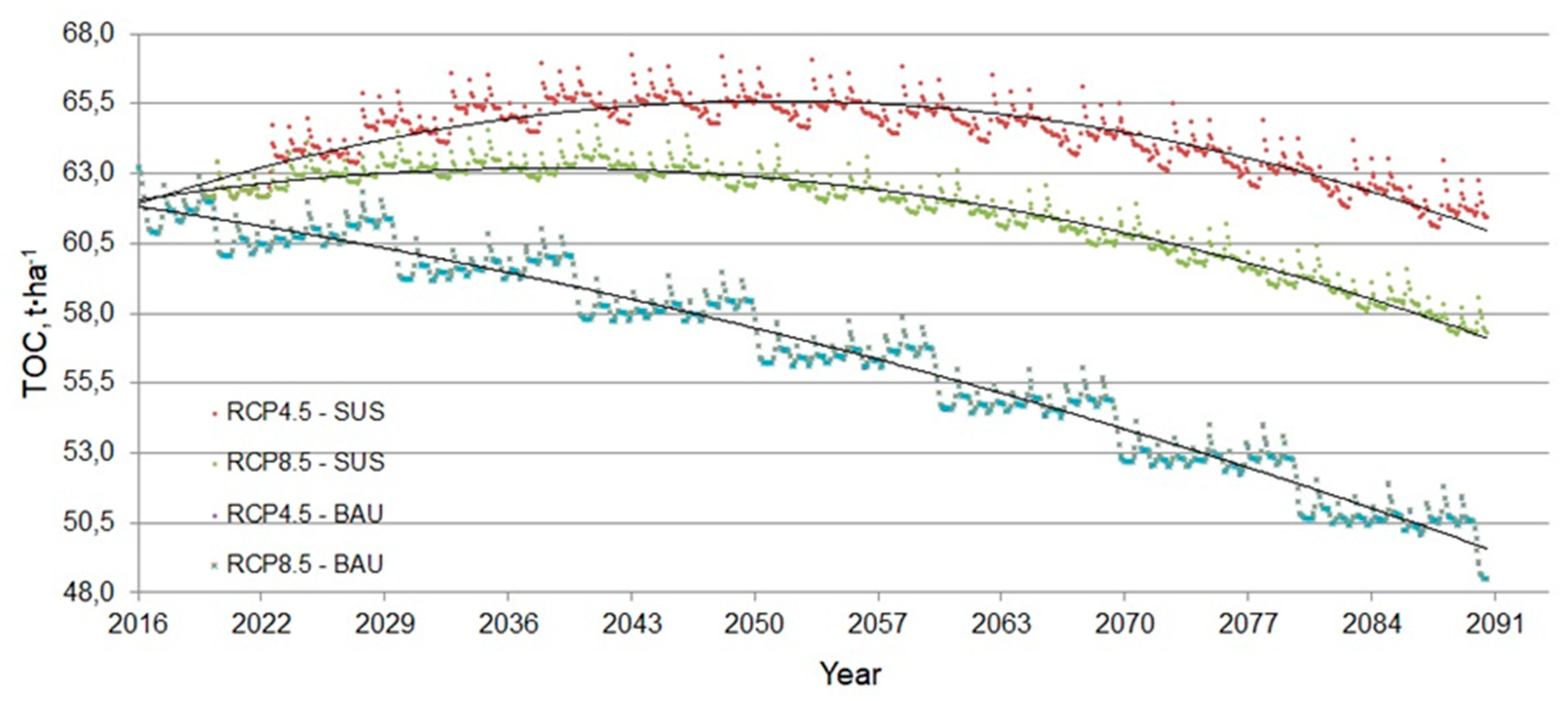
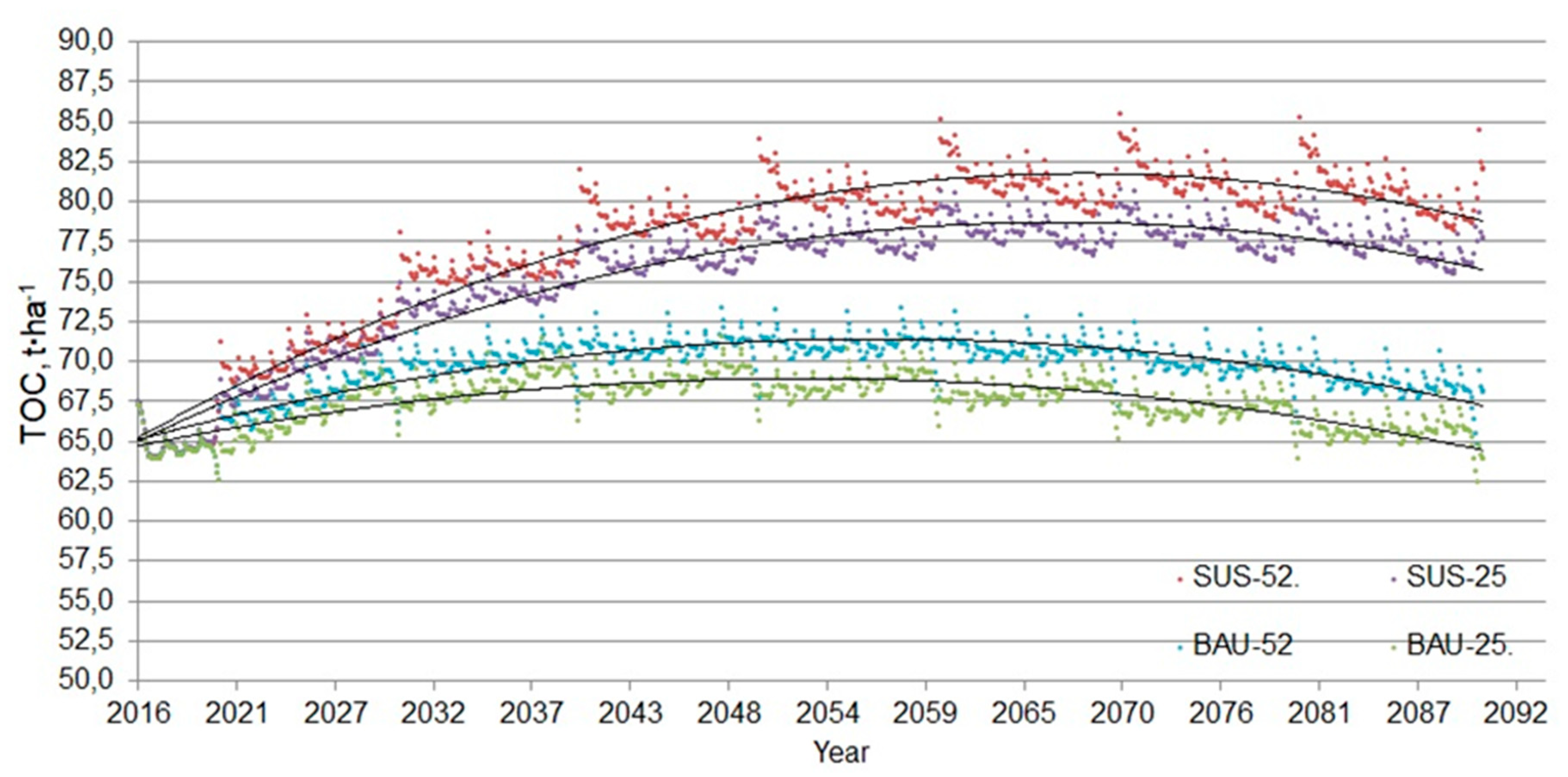

| Treatment | pH-KCl | N-NO3–, mg·kg−1 | Available P2O5 mg·kg−1 | Available K2O mg·kg−1 | Hydrolytic Acidity cmolc·kg−1 |
|---|---|---|---|---|---|
| Control | 5.21 | 14.2 | 106 | 153 | 2.8 |
| 1 NPK | 5.15 | 15.1 | 130 | 197 | 3.4 |
| 2 NPK | 5.24 | 25.2 | 180 | 191 | 3.6 |
| 3 NPK | 5.05 | 24.8 | 188 | 191 | 3.1 |
| Treatment | r 1 | RMSE 2 | EF 3 | CD 4 | M 5 |
|---|---|---|---|---|---|
| Control (36) | 0.88 | 3.92 | −2.15 | 1.37 | −1.31 |
| 1 NPK (39) | 0.80 | 5.20 | −3.59 | 1.62 | −2.24 |
| 2 NPK (31) | 0.92 | 5.43 | −4.61 | 1.10 | −3.04 |
| 3 NPK (32) | 0.94 | 2.75 | −2.25 | 1.02 | −1.53 |
| Changes in SOC Stocks Between 1954 and 2015 | ||||
|---|---|---|---|---|
| Treatment | Control | 1NPK | 2NPK | 3NPK |
| Absolute losses, t·ha−1 | 11.51 | 6.25 | 8.43 | 6.62 |
| Relative loss, % | −15.35 | −8.59 | −10.63 | −8.61 |
| Relative losses per annum, % | −0.25 | −0.14 | −0.17 | −0.14 |
| Mean Annual Value, t·ha−1 | Treatments | |||
|---|---|---|---|---|
| Control | 1NPK | 2NPK | 3NPK | |
| C input with plant residues, experimental, 1954–2015 | 1.443 | 1.590 (88%) | 1.637 (88%) | 1.680 (89%) |
| C input with organic fertilizers, experimental, 1954–2015 | - | 0.218 (12%) | 0.218 (12%) | 0.218 (11%) |
| ΔC, 0–20 cm, model, 1954–2015 | −0.186 | −0.101 | −0.136 | −0.107 |
| CO2 flux to the atmosphere | 1.687 | 1.947 | 2.058 | 2.071 |
| The Increase in SOC Stock for the Period 1964–1971 | ||||
|---|---|---|---|---|
| Treatment | Control | 1NPK | 2NPK | 3NPK |
| Absolute values, t·ha−1 | 1.1 | 2.6 | 2.3 | 2.5 |
| Relative values, % | 1.5 | 3.7 | 3.0 | 3.3 |
| Relative values per annum, % | 0.2 | 0.5 | 0.4 | 0.4 |
Publisher’s Note: MDPI stays neutral with regard to jurisdictional claims in published maps and institutional affiliations. |
© 2020 by the authors. Licensee MDPI, Basel, Switzerland. This article is an open access article distributed under the terms and conditions of the Creative Commons Attribution (CC BY) license (http://creativecommons.org/licenses/by/4.0/).
Share and Cite
Husniev, I.; Romanenkov, V.; Minakova, O.; Krasilnikov, P. Modelling and Prediction of Organic Carbon Dynamics in Arable Soils Based on a 62-Year Field Experiment in the Voronezh Region, European Russia. Agronomy 2020, 10, 1607. https://doi.org/10.3390/agronomy10101607
Husniev I, Romanenkov V, Minakova O, Krasilnikov P. Modelling and Prediction of Organic Carbon Dynamics in Arable Soils Based on a 62-Year Field Experiment in the Voronezh Region, European Russia. Agronomy. 2020; 10(10):1607. https://doi.org/10.3390/agronomy10101607
Chicago/Turabian StyleHusniev, Ilshat, Vladimir Romanenkov, Olga Minakova, and Pavel Krasilnikov. 2020. "Modelling and Prediction of Organic Carbon Dynamics in Arable Soils Based on a 62-Year Field Experiment in the Voronezh Region, European Russia" Agronomy 10, no. 10: 1607. https://doi.org/10.3390/agronomy10101607
APA StyleHusniev, I., Romanenkov, V., Minakova, O., & Krasilnikov, P. (2020). Modelling and Prediction of Organic Carbon Dynamics in Arable Soils Based on a 62-Year Field Experiment in the Voronezh Region, European Russia. Agronomy, 10(10), 1607. https://doi.org/10.3390/agronomy10101607







